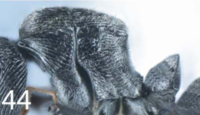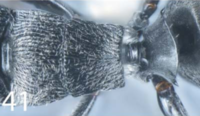Polyrhachis umboi
| Polyrhachis umboi | |
|---|---|

| |
| Scientific classification | |
| Kingdom: | Animalia |
| Phylum: | Arthropoda |
| Class: | Insecta |
| Order: | Hymenoptera |
| Family: | Formicidae |
| Subfamily: | Formicinae |
| Tribe: | Camponotini |
| Genus: | Polyrhachis |
| Subgenus: | Aulacomyrma |
| Species: | P. umboi |
| Binomial name | |
| Polyrhachis umboi Kohout, 2007 | |
Known only from the holotype.
Identification
Kohout (2007) - P. umboi is somewhat similar to Polyrhachis pallipes, but lacks an acute and raised anterodorsal margin of first gastral segment and having less acute pronotal teeth and generally darker appendages.
Keys including this Species
Distribution
Distribution based on Regional Taxon Lists
Indo-Australian Region: New Guinea (type locality).
Distribution based on AntMaps
Distribution based on AntWeb specimens
Check data from AntWeb
Countries Occupied
| Number of countries occupied by this species based on AntWiki Regional Taxon Lists. In general, fewer countries occupied indicates a narrower range, while more countries indicates a more widespread species. |

|
Estimated Abundance
| Relative abundance based on number of AntMaps records per species (this species within the purple bar). Fewer records (to the left) indicates a less abundant/encountered species while more records (to the right) indicates more abundant/encountered species. |

|
Biology
|
Castes
Known only from the worker caste.
Nomenclature
The following information is derived from Barry Bolton's Online Catalogue of the Ants of the World.
- umboi. Polyrhachis (Aulacomyrma) umboi Kohout, 2007a: 211, figs. 38, 41, 44 (w.) NEW GUINEA.
Unless otherwise noted the text for the remainder of this section is reported from the publication that includes the original description.
Description
Worker
Dimensions of holotype: TL c. 5.24; HL 1.31; HW 1.15; CI 88; SL 1.37; SI 119; PW 1.12; MTL 1.28.
Anterior clypeal margin with distinct notch medially; in profile clypeus only very weakly convex with shallow impression just behind anterior margin and moderately impressed basal margin, indicated laterally by break in cephalic sculpture. Frontal triangle indistinct. Frontal carinae sinuate with moderately raised laminate lobes. Head widest just behind eyes, sides converging anteriorly towards mandibular bases. Eyes convex, in full face view clearly breaking cephalic outline. Mesosoma marginate; pronotal and mesonotal dorsa with lateral margins converging posteriorly, propodeal margins parallel. Pronotal humeri armed with angle-like teeth with moderately raised margins, bases weakly emarginate laterally. Promesonotal suture distinct; metanotal groove lacking dorsally, position indicated by slight notch and change in direction of lateral margins. Propodeal dorsum terminating in minute blunt angles, posterior margins continued inwards for only a short distance with dorsum descending into declivity in medially uninterrupted curve. Petiole with dorsal margin acute, weakly jagged; lateral spines curved slightly backwards and upwards. Anterior face of first gastral segment concave, anterodorsal margin distinct, but not acute or raised above dorsal face of segment.
Sculpture of head and mesosoma consisting of more-or-less regularly spaced striae, mostly longitudinal on sides of head, slightly converging on clypeus; striae on vertex curving from posterolateral corners towards central area; a few short, transverse striae along medial preoccipital margin. Pronotal dorsum with striae weakly converging anteriorly, striae on mesonotal-propodeal dorsum distinctly converging posteriorly. Petiole shagreened and somewhat wrinkled. Sides of first gastral segment longitudinally striate, dorsum shagreened.
Head with numerous, erect, rather short, pale yellow hairs not longer than greatest diameter of eye, hairs much less abundant on mesosoma, only few breaking mesosomal outline in lateral view. Gaster with a few short hairs on dorsum of first segment; hairs denser and distinctly longer on ventral surfaces and towards gastral apex. White or silvery, rather diluted, appressed pubescence on head; denser patches on pronotal humeri, propodeal dorsum, metapleuron, coxae and petiole. Propodeal declivity bordered dorsally and laterally by longer and semierect silvery pubescence. Gastral pubescence rather diluted and silvery along posterior borders of tergites; more abundant and pale golden on dorsum of first gastral segment.
Black, tibiae and apical tarsal segments medium to light reddish-brown; funiculi progressively lighter towards apices, terminal segments light reddish-brown.
Type Material
HOLOTYPE: PAPUA NEW GUINEA, Umboi I., 1km N of Awelkom, 600m, 21-28.ii.1967, G. A. Samuelson (worker). Type distribution: unique holotype in Museum of Comparative Zoology.
Etymology
Named after the locality Umboi Island, situated just off the Huon Peninsula along the northeastern coast of Papua New Guinea.
References
References based on Global Ant Biodiversity Informatics
- Janda M., G. D. Alpert, M. L. Borowiec, E. P. Economo, P. Klimes, E. Sarnat, and S. O. Shattuck. 2011. Cheklist of ants described and recorded from New Guinea and associated islands. Available on http://www.newguineants.org/. Accessed on 24th Feb. 2011.
- Kohout R.J. 2007. Revision of the subgenus Aulacomyrma Emery of the genus Polyrhachis F. Smith, with descriptions of new species (pp. 186-253). In Snelling, R.R., Fisher, B.L. & Ward, P.S. (eds). Advances in ant systematics: homage to E.O. Wilson 50 years of contributions. Memoirs of the American Entomological Institute 80: 690 pp.

